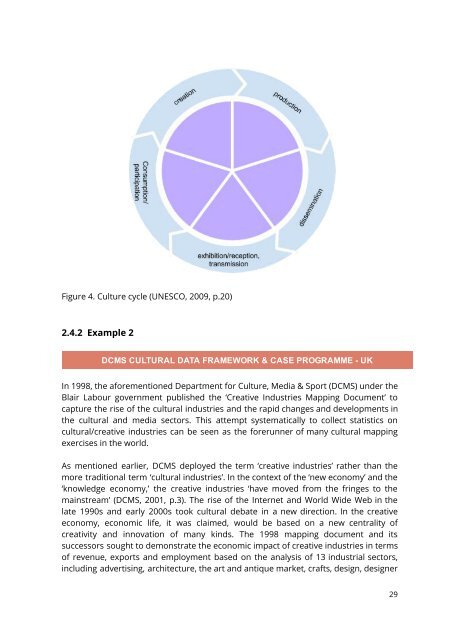MAPPING CULTURE
Mapping-Culture-Venues-and-Infrastructure-in-the-City-of-Sydney
Mapping-Culture-Venues-and-Infrastructure-in-the-City-of-Sydney
Create successful ePaper yourself
Turn your PDF publications into a flip-book with our unique Google optimized e-Paper software.
Figure 4. Culture cycle (UNESCO, 2009, p.20)<br />
2.4.2 Example 2<br />
DCMS CULTURAL DATA FRAMEWORK & CASE PROGRAMME UK<br />
In 1998, the aforementioned Department for Culture, Media & Sport (DCMS) under the<br />
Blair Labour government published the ‘Creative Industries Mapping Document’ to<br />
capture the rise of the cultural industries and the rapid changes and developments in<br />
the cultural and media sectors. This attempt systematically to collect statistics on<br />
cultural/creative industries can be seen as the forerunner of many cultural mapping<br />
exercises in the world.<br />
As mentioned earlier, DCMS deployed the term ‘creative industries’ rather than the<br />
more traditional term ‘cultural industries’. In the context of the ‘new economy’ and the<br />
‘knowledge economy,’ the creative industries ‘have moved from the fringes to the<br />
mainstream’ (DCMS, 2001, p.3). The rise of the Internet and World Wide Web in the<br />
late 1990s and early 2000s took cultural debate in a new direction. In the creative<br />
economy, economic life, it was claimed, would be based on a new centrality of<br />
creativity and innovation of many kinds. The 1998 mapping document and its<br />
successors sought to demonstrate the economic impact of creative industries in terms<br />
of revenue, exports and employment based on the analysis of 13 industrial sectors,<br />
including advertising, architecture, the art and antique market, crafts, design, designer<br />
29



